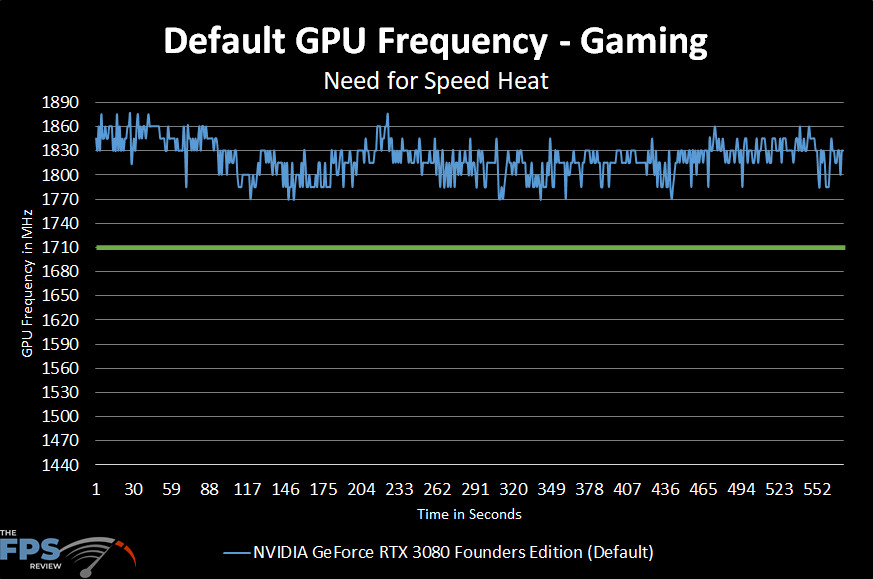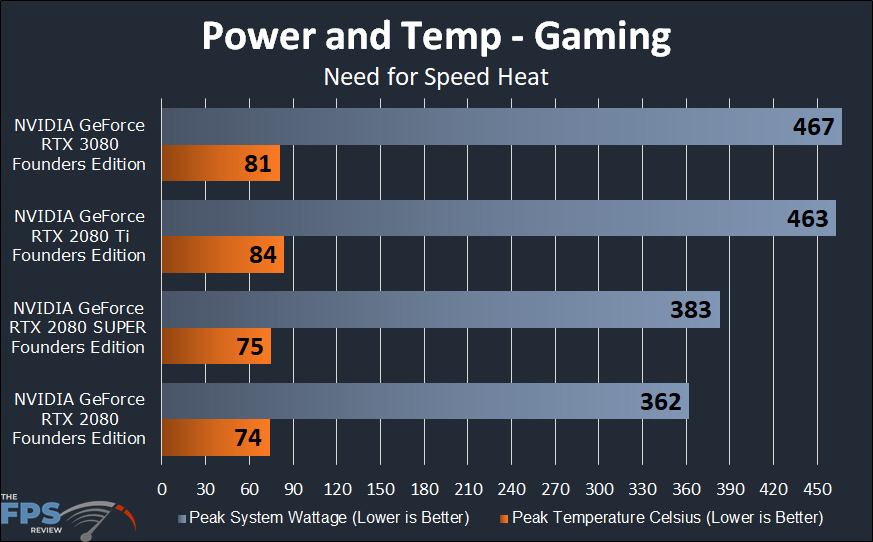Clock – Power – Temp – Overclocking
There are three aspects of the video card we are going to test and show here. First, we need to look at the GPU frequency while gaming to determine if it boosts correctly and by how much. We need to make sure it is holding its frequency without thermal throttling. Second, we need to test the power consumption at the wall of the system to see how each video card stacks up and which is more efficient. Third, we will compare GPU temperatures of all three video cards plus some extra thermal readings across the GeForce RTX 3080 Founders Edition. Finally, toward the bottom, we will try out some Overclocking. Please make sure to scroll down for all the sections.
GPU Clock Frequency
According to NVIDIA the boost clock frequency on the GeForce RTX 3080 Founders Edition is 1710MHz and the base clock is 1440MHz. As such, we’d expect the frequency while gaming to at least run at 1710MHz and not fall under. We need to see what the actual boost frequency is, plus how consistent it is to make sure it is not being held back. We tested the GPU frequency in two games to make sure our results were consistent, and they were. We recorded the frequency over time in GPUz playing a game for over 10 minutes, the graph is below.

From this graph, we can conclude that the GPU frequency does remain above the boost clock of 1710MHz while gaming. It in fact boosts over the boost clock, providing faster performance than the boost clock. It hovers between 1770-1860MHz. The average clock speed of this result is 1821MHz GPU frequency. That’s about a 100MHz average boost from the defined boost clock while gaming. This is good news, it shows that the video card is not thermal throttling the frequency, and the card design actually provides a boost over the boost.
Power and Temp
Total Power Wattage at the Wall of the entire system is used, this is peak Wattage experienced, not the average Wattage, but this is while gaming. Wattage is on the blue bar, and Temperature in Celsius of the GPU reported by GPUz is on the orange bar.
We should note, we did also look at power draw in a game with Ray Tracing and DLSS enabled to confirm the peak Wattage utilizing all parts of the GPU. These peak Wattage numbers were experienced in NFS: Heat at 4K resolution and exceeded those by a couple of Wattages compared to a different game with Ray Tracing and DLSS enabled, so they are very close and match-up.

In terms of Wattage, the GeForce RTX 3080 Founders Edition did peak at the highest, 467W entire system Wattage at the wall. However, this is truly not far off from what the GeForce RTX 2080 Ti Founders Edition also peaked at, which was 463W.
The two are only 4W apart in peak-Wattage, or just 1% difference. Considering the GeForce RTX 3080 FE performs 20-30% faster than the GeForce RTX 2080 Ti FE this result is then very good. For very close to the same power of the GeForce RTX 2080 Ti FE, the GeForce RTX 3080 FE provides 20-30% more performance at the same power. That is indeed an improvement in efficiency and performance per-Watt.
On the average, we saw system Wattage in the 440-450W range while gaming on the GeForce RTX 3080 Founders Edition. It was around 450W when being pushed hard, and lightened up slightly in the 440s when not.
As a replacement for the GeForce RTX 2080 Founders Edition, however, the GeForce RTX 3080 Founders Edition consumes 29% more power at the same price point. In other words, at $699 the GeForce RTX 2080 FE produces 362W, and now at $699 that same price spot now consumes 467W, increasing the power requirement at $699 quite a bit from the previous generation. Granted, you get a 60-90+% performance improvement with that extra power demand, so the performance advantage still outweighs the power increase. Performance isn’t free, and with that comes increased power demand, but the demand isn’t as outrageous as some people were fearing.
In terms of GPU temperature, the GeForce RTX 3080 isn’t actually the hottest. We only saw a maximum GPU temperature of 81c on the GeForce RTX 3080 Founders Edition. This is actually slightly lower than the GeForce RTX 2080 Ti FE. Of course, the RTX 2080 FE and 2080 SUPER are still the lowest. We took some various temperature readings across the video card with an infrared thermometer. Across the top, where the middle fin-stack is, we recorded temps as high as 73c in this area. Pointed at the pass-through fin area we recorded temps in the 64c range, either the temp of the fins or the Heatpipe with the fan pulling air over it. On the back of the video card, we recorded temps around 67c in the hottest areas. It was hard to get a reading on the hot air coming out the I/O bracket, but it felt very warm to the touch, maybe 70c, we’d need to test more to be sure there though.
Keep in mind that this is with an open-air test bench, and we do actually have a side-fan on the platform that blows air across the CPU and VRMs toward the back of the video card. This means it runs hot, and inside a tight case with cramped airflow, we might be concerned. Therefore once again, at $699 you now have to accept a warmer GPU temperature range than before at $699.
GPUz
Here you will find the GPUz screenshot while running for over 10 minutes in Need for Speed Heat. A few interesting notes, the fans did run over half their speed, the Board Power Draw was 327W and the GPU Voltage hit 1.0750V. The TGP of this video card is 320W, so we are right there on hitting the maximum power limits at default. The GPU frequency did spike at 2010 but this was only during game load, not while the game was actually being played.
We should also note, Ray Tracing and DLSS were not being used in this test, and those features being enabled could change some results like temperature as it utilizes other parts of the GPU. We will have to test different scenarios to see if that does affect anything.
Overclocking Preview
We will have a full-overclocking follow-up review after this launch of the GeForce RTX 3080 FE. Until then, we thought we’d take the extra time we were given and do a little overclocking preview for you. We focused on just playing with overclocking the GPU separately and the memory separately. These are in no way the final stable overclocks we are about to show you, simply something we were able to hit very quickly and seemed to work stable enough. These were done separately, and not combined together.
GPU Core


We used MSI Afterburner, which worked, however, we weren’t able to unlock the Voltage. We discovered that the Power Limit could be increased to 115% from 100%. Leaving the fans at default/automatic and by pushing the GPU offset to +50 we got the result you see in the graph. The overclock pushed the frequency up from around 1790MHz up to 1990MHz, about a 200MHz increase over the default performance. We think that it should be possible to get a stable 2000MHz (2GHz) out of this GPU consistently, especially if we raise the fan speed or have more robust cooling in custom cards. It might even be possible to go higher if you are lucky, but I have a feeling the average OC is going to be around 2GHz, which is a nice bump from the default frequency of 1790-1800MHz.
What we really got a huge bump from though by increasing the Power Limit and Offset was a Wattage bump. The System Wattage peaked at a very scary high 539W with just this GPU overlock, not even memory combined. The default Wattage remember was 467W, so that’s a 15% power increase from this GPU only overclock and no Voltage added. BTW, GPUz reported board power now at 373W and TDP at 116.7%. It also seems that the GPU Voltage was automatically increased to 1.0810V from the default. GPU temp rose to 83c with the fans on automatic.
Memory
We managed to push the memory up to +800 in Afterburner. Remember, this new GDDR6X has to be calculated a bit differently, if you are looking at the frequency, single-data-rate in GPUz it’s 1188MHz, you need to multiply this by 16 to get the effective rate of 19GHz, that’s the default. At +800 the single-data-rate moves up to 1288MHz, so multiply by 16 and you get a 20.6GHz effective rate. Therefore, this overclock of +800 brings the memory up to 20.6GHz and that gives us 824GB/s of bandwidth versus 760GB/s default. We also think this can be pushed a bit higher, but keep in mind this was memory alone, without the GPU overclock. With both combined the tolerances may change, especially board power and hitting the TDP wall faster.
With the memory bumped up to 20.6GHz the power draw climbed to a peak of 524W from the default of 467W. That is just with the memory alone. That’s a 12% power increase just from that.
Now you can see the power problem with overclocking, if the GPU overclock alone, and the memory overclock alone consumes so much power, imagine when you combine them. This is also all without changing the voltage manually. The point is, the main problem once again is going to be hitting the TDP/TGP limits very quickly with this video card. Also, your primary power Wattage draw is going to skyrocket. If overclocking, get a beefy PSU, that’s new (not old) and has stable Voltage regulation.



